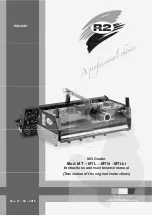
4.
Re-install bowl to the filter head. Make sure O-ring
is positioned properly between bowl mounting nut
and the filter head.
5.
Open the fuel shut-off above the filter.
6.
Open the bleed screw on the filter mounting head to
re-fill the bowl with fuel. Close the bleed screw.
CHANGING THE HYDRAULIC OIL
AND FILTER
(Fig. 26)
Initially change the hydraulic oil filter after the first 50
operating hours. After that, change the hydraulic oil and
filter after every 800 operating hours. If the oil becomes
contaminated, contact your local TORO distributor
because the system must be flushed. Contaminated oil
looks milky or black when compared to clean oil.
1.
Clean the area around the filter mounting area.
Place the drain pan under the filter and remove the
filter.
Note: If the oil is not going to be drained,
disconnect and plug hydraulic line going to the
filter.
Figure 26
1.
Hydraulic filter
2.
Fill the replacement filter with Mobil 424 hydraulic
fluid, lubricate the sealing gasket and hand turn
until the gasket contacts the filter head. Then
tighten 3/4 turn further. The filter should now be
sealed.
3.
Fill the hydraulic reservoir with 20.8 L of hydraulic
oil. Refer to Check the Hydraulic System.
4.
Start the machine and run it at idle for 3 to 5
minutes to circulate the fluid and remove any air
trapped in the system. Stop the machine and
recheck the fluid level.
5.
Dispose of the oil properly.
CHECKING HYDRAULIC LINES
AND HOSES
Inspect hydraulic lines and hoses daily for leaks, kinked
lines, loose mounting supports, wear, loose fittings,
weather deterioration and chemical deterioration. Make
all necessary repairs before operating.
ADJUSTING CUTTING UNIT
LIFT/DROP
The machine’s cutting unit lift/drop circuit is equipped
with a flow control valve. This valve is preset at the
factory at 3 turns open, but an adjustment may be
required to compensate for differences in hydraulic oil
temperatures, mowing spreads, etc. If an adjustment is
required, proceed as follows:
1. Allow hydraulic oil to reach full operating
temperature before adjusting the flow control valve.
2. Raise the seat and find the flow control valve
mounted to the hydraulic cylinder.
Figure 27
1.
Flow control valve
27
Maintenance
Keep your body and hands away from pin hole leaks or
nozzles that eject high-pressure hydraulic fluid. Use
cardboard or paper to find hydraulic leaks. Hydraulic
fluid escaping under pressure can penetrate your skin
and cause injury. Fluid accidentally injected into your
skin must be surgically removed within a few hours by
a doctor familiar with this form of injury or gangrene
may result.
WARNING






































